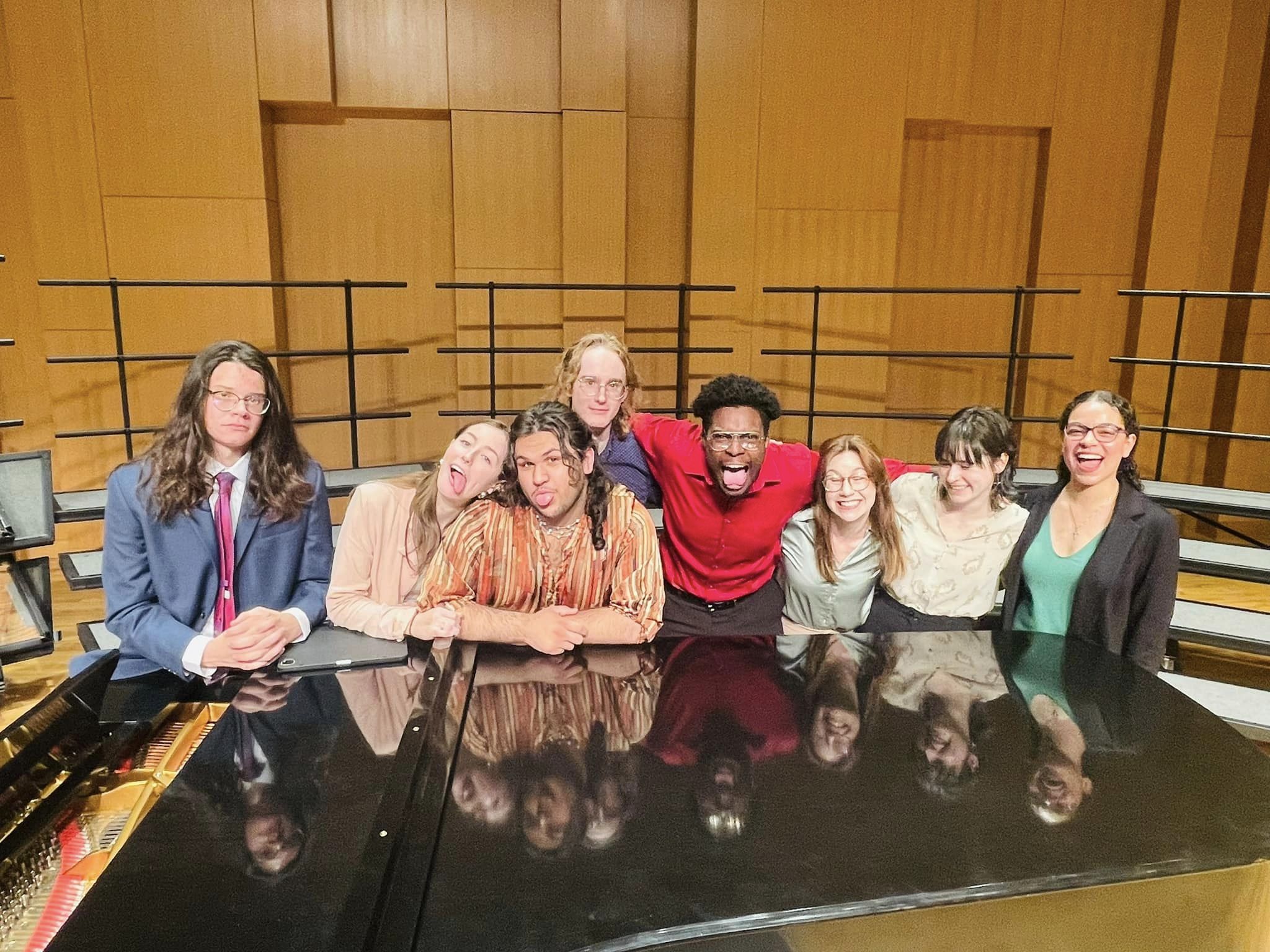Pastiche – defined by the Webster dictionary is “a literary, artistic, musical, or architectural work that imitates the style of previous work”. Long enough ago to where my memory begins to waver, a teacher of mine told me that all art is imitation. And of course, we know that imitation is the sincerest form of flattery.
Inspired by the beauty of life, who wouldn’t be compelled to create, to sing, to draw? Whatever it is that one does best, it has certainly been inspired by some external muse in order to create a more beautiful world. To see artistic disciplines work in tandem has alway intrigued me, from the synesthetes, people who can hear color, to the those who simply listen to music while getting work done. Music compels and urges us to be better, to make the world around us better, or at the very least, lightens the heart.
I decided on this concept because I wanted a new way to understand the music I love so much and how it may affect someone else who isn’t – well, me. I wanted a physicalization of their thought process, of the emotions they felt while listening to these pieces, and of their unique world view. That is why, during the process of creating this recital, I tasked five artists, including myself, to listen, analyze, and create an artwork based off of each musical set.
The artists had free range to express their creativity (i.e. sculpt, paint, draw, graphic design, even live performance art if they wished) so long as it derived from the music. It has been a pleasure working with each one of these artists, and now hopefully friends. Watching their processes unfold step by step, slowly reviling bits and pieces of what was going on in their minds and identifying what part of the music was influencing them during the process, and even being able to see an artist go to work, has been an absolute privilege. These artists and their work has given me a new perspective of the music that I haven’t considered before. It is my hope that you take something away, not from just the silly little sounds that I will be making, but from the artists who have put so many hours into this project as well.
Composer – Claudio Monteverdi Artist – rINN Yanas
I. Si dolce è’il tormento Quarto scherzo delle ariose vaghezze
Blah blah blah this is what its about
II. Lamento della ninfa Libro VIII: Madrigali guerrieri e amorosi, no. 18 (1623)
Blah blah blah this is what its about
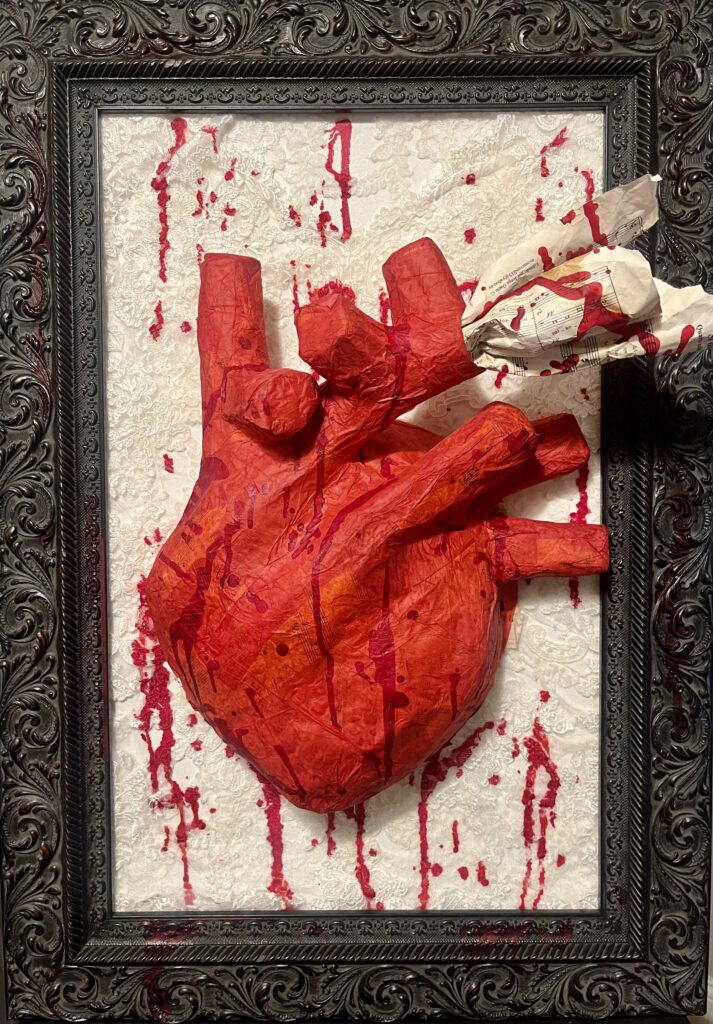
Rinn Yanas
‘Languish and Longing‘
Papermache, on textile. This piece was inspired by the two songs “Si dolce e il tormento” and “Lamento della ninfa”. Both songs expressed a deep longing for something you know is painful and isn’t good for you, and still you languish for it anyway. Both pieces speak of this discord through the phrase “fire and ice”. To me this highlighted the dichotomy of the songs: the longing and the languishing. Because the was so honest and open about these very raw feelings I was inspired to create a piece that showcased that. The paper mâché anatomical heart in cherry red represents the very real and intense feelings of a spurned love but also plays with the almost child like infatuation and idealism of that love. I wanted to juxtapose this conflicting image on something seemingly simple and pure. The background is made of lace from a wedding dress. The dress was acquired from an actual would be bride who called off the wedding just 2 weeks before the day.
A charm of lullabies
Composer – Benjamin Britten Artist – Casey Landerkin
I. A Cradle Song
II. Sephestia’s Lullaby
III. A Charm
IV. The Nurses Song
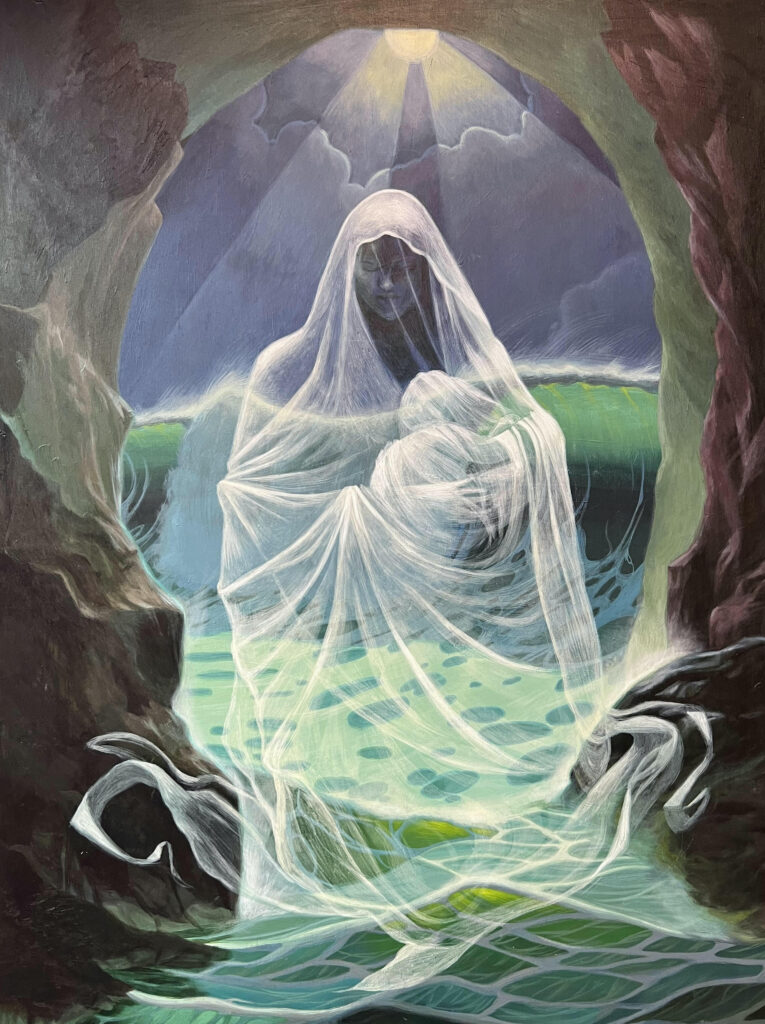
Casey Landerkin
‘Lullaby’
Acrylic, on wood. This piece, based on songs from “The Charm of Lullabies”, is a reflection of an aspect of motherhood that is sometimes hidden from the world. While motherhood can be a beautiful experience, it can also at times feel binding, and a possible loss of self. The music feels both panicked, melancholy, frenetic, but also beautiful, loving, and soothing. The mother would not be singing her baby a lullaby if she did not care for the child. The clashing of the melodies and lyrics creates an unmistakable, uncomfortable dissonance that I wanted to somehow portray in my painting. In the middle is the transparent figure of a woman holding a baby, looking at the viewer staring out from the cave. She is there, but also not there. She is at the threshold between who she truly might be and who the world has told her she must be, all the while cradling her baby to her breast. I simultaneously wanted to depict her experience, but also give her the gift of flight, so she could be light enough to be free from the strong current hoping to sweep her into the warm cramped cave.
The work at hand
Composer – Jake heggie Lyricist – LAURA MOREFIELD Artist – UNKNOWN
I. Part One: Individual Oragami
II. Part Two: Warrior 1
III. Part Three: The Slow Seconds
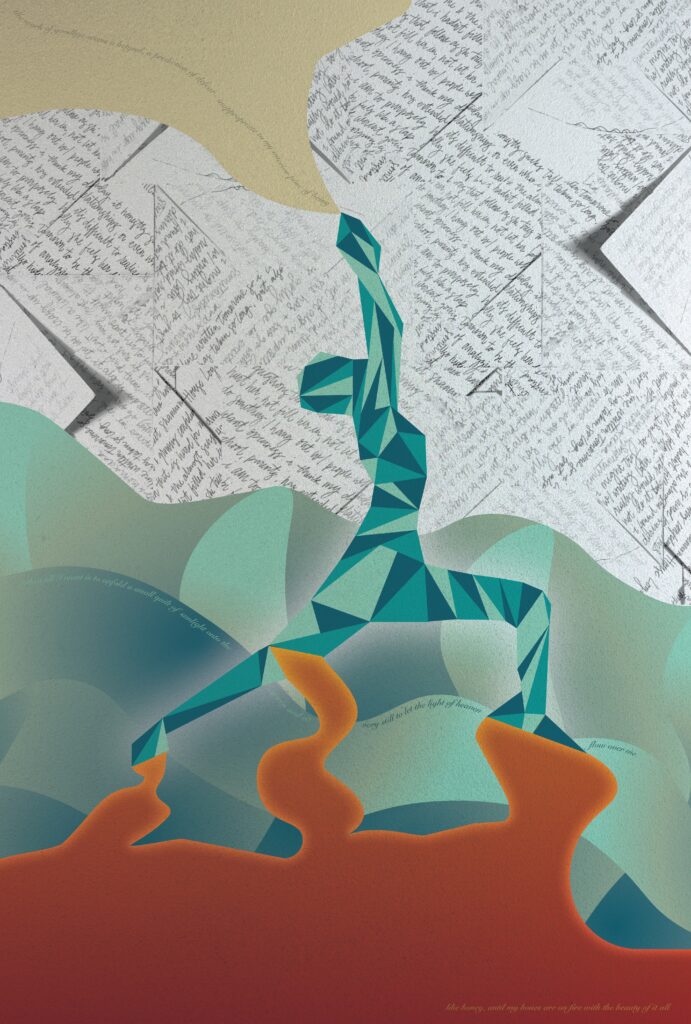
Claire Perry
‘Letterforms’
Digital Image. This piece, based on the three-song collection “The Work at Hand,” seeks to jell the subject, themes, and emotions of each poem seamlessly into one messy yet peaceful composition. The scattered origami letters, made of pages from my personal journal, reference the first vignette. As she grapples with the weight of documenting her life through the lens of other’s influence, Morefield is full of unwavering haste. Thus, begins her “long goodbye” of individual letters to the people who have made her life worthy of joy, courage, and hope. The center figure features a woman connected to herself and rooted in her defiance of fate as she stands in the yoga pose “Warrior One.” The geometric representation seeks to reference the integral creases that shape origami and highlight the powerful community she has built that allow her to stand strong in the face of defeat. The juxtaposing flow of orange begins the last poem as Morefield accepts the honey-like “light of heaven.” While in a meditative state at the end of the piece, she is able to relax on a quilt on the “cool green,” as long as her last breath will take her.
Trois Chanson de bilitis
Composer – Claude Debussy Lyricist – Pierre Louÿs Artist – Julian Yanas
I. la flûte de Pan
II. la Chevelure
II. le tombeau des Naiades
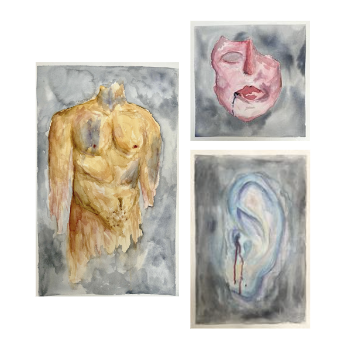
Julian Yanas
‘To be held by him’
Watercolor, on paper. I was initially drawn to the lofty music that is so characteristic of Debussy’s work but it was the text that truly inspired me to create something more. Through my research into artists for this project I stumbled upon Ali Walker the founder of the /200 Project, a large scale art project to communicate the imbalance of justice for survivors of sexual assault. Like Ali I wanted a way to heal the way I saw my body, to get a weight off my chest, acknowledge and move past a darker time in my life, and to find beauty in a body that i no longer felt was mine alone. I chose to paint an ear, mouth, and chest – parts of my body that carry a dark memory of my youth that I have decided to take and leave on the canvas.
From jewish folk poetry
Composer – Dimitri Shostakovich Artist – Sydney lewandowski
I. The lament for the dead child
II. The thoughtful mother and aunt
III. Lullaby
IV. Before a long parting
VII. The song of misery
XI. Happiness
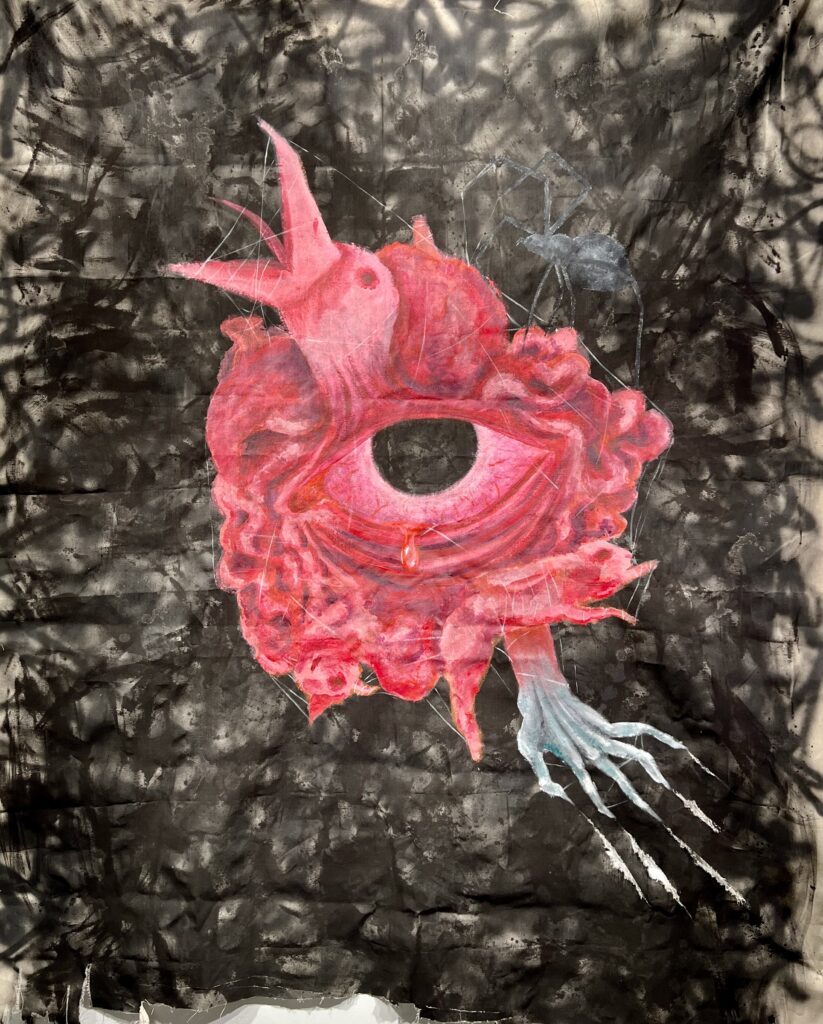
Sydney Lewandowski
‘We Are So Happy, We Are Free‘
Acrylic and ink, on canvas. In this piece, I wanted to represent the pain and suffering that was expressed to in Jewish Folk Poetry by Dmitri Shostakovich. Julian and I discussed during my brainstorming process the historical significance of the music, which included it being created during Stalin’s regime, and was commentary on the Soviet Union’s mistreatment of Jewish individuals. Shostakovich successfully made the piece in spite of the oppressive government. While listening to the music, I pulled specific lines, such as the description of a child naked in a cradle, a spider weaving misfortune, and a multitude of animals, and combined them into a fusion of suffering. I reflected on authoritarian governments oppressing the people they are supposed to protect, and wanted to represent the abuse permitted and how people’s lives were stolen from them. And as I created the amalgamation of pain, I reflected on the rampant antisemitism, the propaganda permitted, and thought how we as a society must do everything in our power to make sure we never allow mass genocide ever again.

